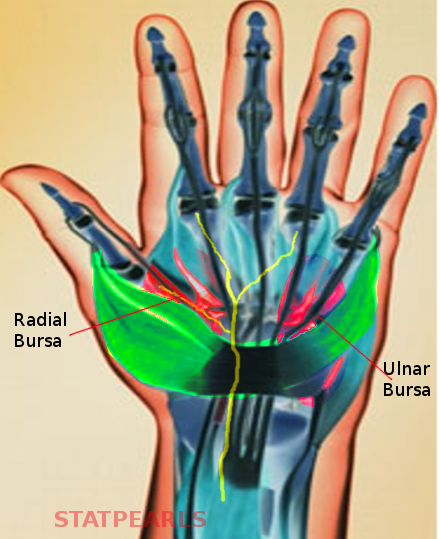[2]
Fussey JM, Chin KF, Gogi N, Gella S, Deshmukh SC. An anatomic study of flexor tendon sheaths: a cadaveric study. The Journal of hand surgery, European volume. 2009 Dec:34(6):762-5. doi: 10.1177/1753193409344529. Epub 2009 Oct 12
[PubMed PMID: 19822633]
[3]
Aguiar RO, Gasparetto EL, Escuissato DL, Marchiori E, Trudell DJ, Haghighi P, Resnick D. Radial and ulnar bursae of the wrist: cadaveric investigation of regional anatomy with ultrasonographic-guided tenography and MR imaging. Skeletal radiology. 2006 Nov:35(11):828-32
[PubMed PMID: 16688447]
[4]
Hita-Contreras F, Martínez-Amat A, Ortiz R, Caba O, Alvarez P, Prados JC, Lomas-Vega R, Aránega A, Sánchez-Montesinos I, Mérida-Velasco JA. Development and morphogenesis of human wrist joint during embryonic and early fetal period. Journal of anatomy. 2012 Jun:220(6):580-90. doi: 10.1111/j.1469-7580.2012.01496.x. Epub 2012 Mar 19
[PubMed PMID: 22428933]
[5]
de la Garza O, Lierse W, de los Angeles-García M, Elizondo R, Guzmán S. The arterial blood supply for the synovial tendon sheaths of the hand. Revista de investigacion clinica; organo del Hospital de Enfermedades de la Nutricion. 2008 Jan-Feb:60(1):31-6
[PubMed PMID: 18589585]
[6]
Lung BE, Siwiec RM. Anatomy, Shoulder and Upper Limb, Forearm Flexor Carpi Ulnaris Muscle. StatPearls. 2023 Jan:():
[PubMed PMID: 30252307]
[7]
SCHELDRUP EW. Tendon sheath patterns in the hand; an anatomical study based on 367 hand dissections. Surgery, gynecology & obstetrics. 1951 Jul:93(1):16-22
[PubMed PMID: 14855245]
[8]
Resnick D. Roentgenographic anatomy of the tendon sheaths of the hand and wrist: tenography. The American journal of roentgenology, radium therapy, and nuclear medicine. 1975 May:124(1):44-51
[PubMed PMID: 1147163]
[9]
Fnais N, Gomes T, Mahoney J, Alissa S, Mamdani M. Temporal trend of carpal tunnel release surgery: a population-based time series analysis. PloS one. 2014:9(5):e97499. doi: 10.1371/journal.pone.0097499. Epub 2014 May 14
[PubMed PMID: 24828486]
[10]
Forward DP, Singh AK, Lawrence TM, Sithole JS, Davis TR, Oni JA. Preservation of the ulnar bursa within the carpal tunnel: does it improve the outcome of carpal tunnel surgery? A randomized, controlled trial. The Journal of bone and joint surgery. American volume. 2006 Nov:88(11):2432-8
[PubMed PMID: 17079401]
Level 1 (high-level) evidence
[11]
Patel DB, Emmanuel NB, Stevanovic MV, Matcuk GR Jr, Gottsegen CJ, Forrester DM, White EA. Hand infections: anatomy, types and spread of infection, imaging findings, and treatment options. Radiographics : a review publication of the Radiological Society of North America, Inc. 2014 Nov-Dec:34(7):1968-86. doi: 10.1148/rg.347130101. Epub
[PubMed PMID: 25384296]
[14]
Aboonq MS. Pathophysiology of carpal tunnel syndrome. Neurosciences (Riyadh, Saudi Arabia). 2015 Jan:20(1):4-9
[PubMed PMID: 25630774]
[15]
Lee SM, Lee WJ, Song AR. Tuberculous tenosynovitis and ulnar bursitis of the wrist. Annals of rehabilitation medicine. 2013 Aug:37(4):572-6. doi: 10.5535/arm.2013.37.4.572. Epub 2013 Aug 26
[PubMed PMID: 24020040]

